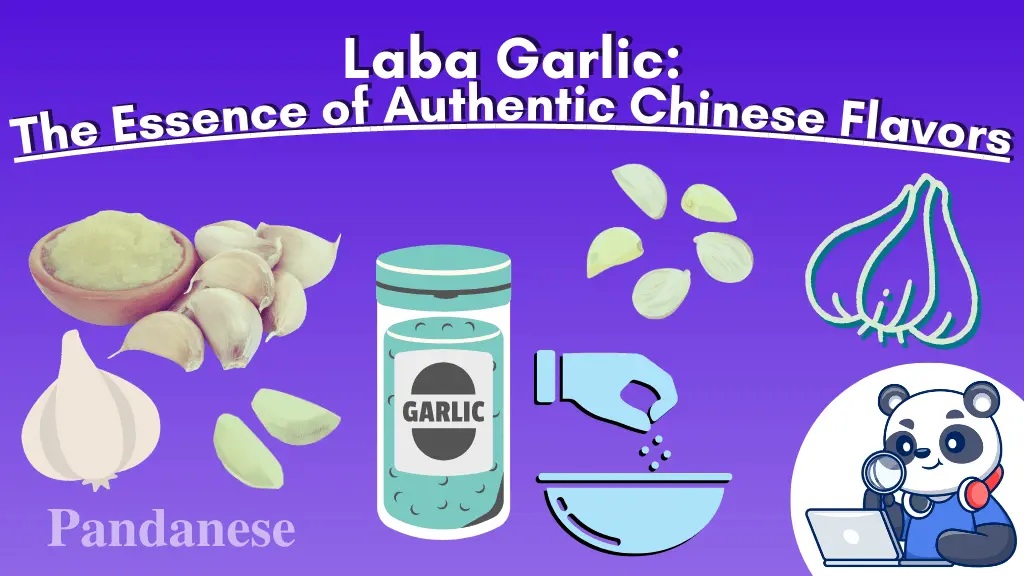
Laba Garlic: The Essence of Authentic Chinese Flavors
Ever seen this?

Blue garlic, lifehacker
Your eyes are not fooling you; that's blue garlic! Also called Laba garlic or pickled green garlic, it has a history in Chinese food that combines sweet, spicy, and sour.
Let’s take an exciting culinary journey to learn more about this amazing food!
Is Laba garlic Chinese?
Yes, it is a Chinese pickled side dish or condiment. Laba Garlic is known for its unique sweet and savory flavor and is used in various Chinese dishes to add depth and aroma.
Laba garlic origins:
What is the history of Laba garlic?
The history of Laba Garlic can be traced back to ancient China and its association with the Laba Festival. This festival is celebrated on the eighth day of the twelfth Chinese lunar calendar.
The origins of Laba Garlic can be attributed to offering sacrifices to ancestors and deities during the Laba Festival. Thus, garlic was believed to have strong protective and cleansing properties and was an essential ingredient in the offerings.
So over time, this practice evolved, and people began to consume the garlic themselves to bring good luck and ward off evil spirits.
Why do Chinese people eat Laba garlic?
The practice of making Laba garlic specifically during this festival is especially popular in Northern China due to traditions, customs, and symbolic meanings, but also for its flavor.
It's sour yet juicy with a crispy texture accompanied by slight spiciness, an unforgettable flavor enjoyed by many households throughout China.
A combination of superstition, culinary enjoyment, health considerations, and the desire to uphold cultural traditions and beliefs is why Chinese people eat Laba garlic.
Why does Laba garlic change color?
Garlic cloves have sulfur-containing compounds and the enzyme alliinase. When being pickled in something acidic such as vinegar or lemon juice, a reaction will occur between them, resulting in a beautiful blue-green garlic.
A simple scientific explanation of why garlic can turn green or blue, Beryl ShereshewskyOlder garlic contains more sulfur resulting in it changing to green much faster.
A comprehensive guide to Chinese Laba garlic
There is no perfect Laba garlic recipe, but we will give you the basics of making Chinese Laba garlic from ingredients, recipes, and troubleshooting tips.
Laba garlic ingredients

Laba garlic is garlic soaking in vinegar and sugar
To make your own Laba garlic pickles, you need to start with the essential ingredient:
garlic cloves*
vinegar (e.g., rice, white, or brown)
sugar
Additionally, you need clean glass jars or any airtight container to hold everything.
*You can use fresh garlic. However, older garlic cloves have more of the enzyme that will allow them to change color more vibrantly and more quickly.
How to make Laba garlic: step-by-step instructions:
Peel, wash, and remove the garlic root.
Placed the cleaned garlic into the container
Warm enough vinegar to submerge the garlic with a spoonful of sugar
Pour the warm vinegar-sugar mixture with the garlic
Close the container tightly and store it in a low-temperature environment
Usually, it takes about 2-20 days for the garlic to turn green, depending on the vinegar's acidity and freshness of the garlic.
Troubleshooting Tips and Tricks
Why is my Laba garlic not turning green?
There are a couple of factors if your Laba garlic is not green.
Your vinegar's acidity is not acidic enough
Fresh garlic has less sulfur content. Older ones have more enzymes to react with the vinegar.
Which vinegar is used for Laba garlic?
Laba garlic is traditionally pickled using rice vinegar, owing to its delicate taste and low acidity.
White vinegar, black vinegar, or brown vinegar can also be used to add a variety of flavors when picking your Laba garlic.
Feel free to try out different types of vinegar and add flavoring, such as soy sauce, until you find the one that best suits your palate!
What do you eat Laba garlic with?

Chinese dumpling with laba garlic, ThousandLemons
Laba garlic and dumplings
The most classic combination with Laba garlic in Chinese cuisine is with dumplings.
Eating it as whole or minced with the dumpling adds an extra refreshing and zesty to balance out the dumplings' rich and savory flavors.
What is the health benefit of Laba garlic?
Laba garlic has many potential health advantages.
It contains anti-tumor, antioxidant, and cytotoxic properties, which can help with cancer therapy. Additionally, it can improve digestion and can boost your immune system.
How long can Laba garlic lasts?
Laba garlic has many different shelf life days, ranging from 20 days without refrigeration to 4 months refrigerated.
Similar to pickled garlic, it's best to go off your opinion. If the garlic tastes a bit off, your smell in the container is bad, or you see mold, it's time to make a new batch.
Additionally, always use a cleaned spoon or chopsticks to grab the garlic so the vinegar mixture is not contaminated.
Frequently asked questions
Is it safe to eat Laba garlic?
Yes, eat Laba garlic is perfectly safe to eat. It is similar to pickled garlic or anything pickled.
Always look out for moldy smells or growth before eating it.
In closing
Laba garlic is an amazing addition to any meal, providing a tasty and interesting flavor with its unique cultural background.
Take up the challenge for anyone who has yet to try this delightful ingredient. It's quick and easy to make. You won’t regret adding Laba garlic to your meals!
The easiest way to learn Chinese & build vocabulary

